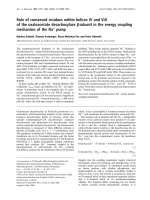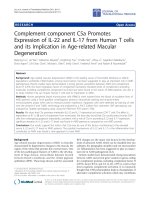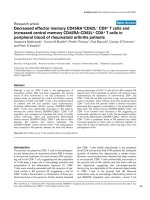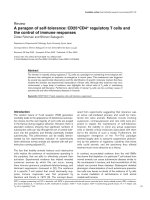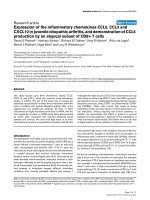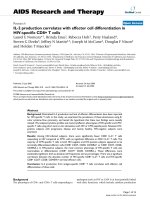The role of CD8 t cells in the differentiation of TNF iNOS producing dendritic cells and TH1 responses
Bạn đang xem bản rút gọn của tài liệu. Xem và tải ngay bản đầy đủ của tài liệu tại đây (4.13 MB, 279 trang )
THE ROLE OF CD8 T-CELLS IN THE DIFFERENTIATION OF
TNF/INOS-PRODUCING DENDRITIC CELLS AND TH1
RESPONSES
CHONG SHU ZHEN
(ZHANG SHUZHEN)
B.Sc (Hons), NUS
A THESIS SUBMITTED
FOR THE DEGREE OF DOCTOR OF PHILOSOPHY
NUS GRADUATE SCHOOL FOR INTEGRATIVE SCIENCES
AND ENGINEERING
NATIONAL UNIVERSITY OF SINGAPORE
2012
2
Abstract
In this study, we showed that activated human CD8 T-cells could induce DCs to produce
IL-12p70 in vitro and this interaction also resulted in the production of a cytokine milieu
that promoted the differentiation of monocytes into TNF/iNOS-producing (Tip) DCs.
These Tip-DCs expressed high levels of MHC class II and upregulated co-stimulatory
molecules CD40, CD80, CD86 and the classical DC maturation marker CD83. Tip-DCs
exhibited T-cell priming ability and were capable of further driving Th1 responses,
through their expression of TNF-α and iNOS, by priming naive CD4 T-cells for IFN-γ
production. Finally, we showed that the ability of CD8 T-cells to differentiate monocytes
into Tip-DCs also occurred in an in vivo mouse model of allergic contact hypersensitivity
(CHS). This differentiation and activation of Tip-DCs during CHS responses were
observed to be compromised in β
2
m
-/-
, IFN-γ
-/-
and CCR2
-/-
mice and mice that were
depleted of CD8, but not CD4, T-cells. In particular, the presence of Tip-DCs was
significantly increased in mice that have been treated with a Th1-inducing topical
sensitizer, DNCB, but not in mice that have been treated with a Th2-inducing sensitizer,
TMA. Collectively, our results identify a role for CD8 T-cells in orchestrating Th1-
mediating signals, not only through the rapid initiation of DC IL-12p70, but also through
the differentiation of monocytes into Tip-DCs.
3
Acknowledgements
First and foremost, I would like to express my sincere gratitude to my supervisor, Prof
Kemeny, for the invaluable guidance throughout this journey. Thank you for all the
opportunities you have given me, for sacrificing your precious weekends to go through
my analysis and for always giving me your utmost support to pursue my hypothesis, no
matter how strange they were at the beginning, for the project. The story of the Tip-DCs
would not have been possible if it was not for your unconditional support and guidance.
You have also taught me more than good science, but also how to appreciate and deal
with life’s challenges which I am really grateful for.
To Dr Veronique, I really appreciate all the help you have provided especially with
regards to experimental techniques and in vivo setups. Thank you for sharing with me all
your scientific experiences and for also providing such inspiration as a working mother
who is able to juggle both family life and science to the fullest. I am eternally grateful for
your generous support and for being a friend who encourages me to achieve my fullest.
To Dr Paul, thanks for giving me so much help at the beginning when I first stepped into
the lab, especially with regards to the project on human work. I am also grateful for your
invaluable advice on manuscript writing and editing and definitely thankful for the
precious time you have taken to edit all my manuscripts! You have also taught me how to
deal with difficult rebuttals which would be a valuable skill I will take with me when I
graduate.
To the Kemeny Lab members, you guys have been the best labmates one could ever ask
for. Thank you not only for all the help in the lab, but for also being such great friends to
have outside work. It has been an enjoyable five years with all the scientific jokes and I
really enjoy the conference trips and spontaneous photography outings we have had.
Special thanks also go out to Kok Loon and Lingen, who were my mentors at the very
beginning of my project. You guys have given me invaluable support and advice for this
project which would not have started on track without your generous help. To Benson,
4
Guo Hui and Elsie, I am very thankful for all the lab support you guys have provided
with regards to the purchasing and lab orders. Benson, thank you for always making sure
my mice are well fed and breeding well and for always being there to lend a supporting
hand for any problems I have with the mice. To Guo Hui, I am grateful for the support
you have given me with regards to the human work. To the flow lab team, Fei Chuin and
Paul, I am eternally thankful for the support with regards to flow cytometry and for
always being there to answer any of my queries. You guys are the best flow support team
one can ask for!
I would also like to thank the Veronique lab members for giving me support and advice
with regards to mice work. Special thanks go out to Karwai and Fiona, for teaching me
how to handle the mice, for all experimental techniques related to mice work and for all
the laughter and joy during the long experimental days. I am also grateful to Angeline for
providing me invaluable help and support with regards to the skin anatomy and structure
and to Michael, Kim and Jocelyn for technical support. I would also like to express my
gratitude to other members of the Immunology Programme such as Joshua, Fatimah,
Hazel and Boon Keng for their help in one way or another.
Lastly, I would like to thank my family, especially my parents and brother, for being so
supportive and accommodative during my phD. Thanks for all the encouragement and for
always believing in me. To my husband, JJ, thank you for always being there for me
through the good and the bad. Words cannot express how thankful I am to have your
unconditional support through these years and for all the inspirational stories you have
provided to keep me going.
5
Table of Contents
CHAPTER 1: Introduction 18
1.1 Immunity 18
1.1.1 Innate Immunity 18
1.1.2 Adaptive immunity 19
1.2 CD8 T-cells 20
1.2.1 Activation of CD8 T-cells 21
1.2.2 CD8 T-cell subsets 22
1.3 Dendritic cells 23
1.3.1 Activation of DCs 24
1.3.2 Heterogeneity of DCs in mice 25
1.3.3 Heterogeneity of DCs in humans 27
1.4 T helper responses 29
1.4.1 Th1 and Th2 cells 29
1.4.2 Th17 and Treg cells 29
1.4.3 Control of T helper responses 30
1.4.4 Transcription factors 31
1.5 Interleukin-12 32
1.5.1 IL-12p40 33
1.5.2 Importance of IL-12p70 33
1.6 Modulation of DCs by immune cells 35
1.6.1 Modulation of DCs by B-cells 35
1.6.2 Modulation of DCs by mast cells and fibroblasts 36
1.6.3 Modulation of DCs by NK cells 36
1.6.4 Modulation of DCs by CD4 T-cells 37
1.6.5 Modulation of DCs by CD8 T cells 37
1.7 Bystander mediated effects 39
1.7.1 Bystander mediated effects on uninfected cells 39
1.7.2 Bystander activation of T-cells 40
1.7.3 Bystander activation or suppression of immune responses 41
6
1.8 Monocytes 42
1.8.1 Monocyte heterogeneity 42
1.8.2 Developmental relationship of monocyte subsets 43
1.8.3 Functional heterogeneity of monocyte subsets 44
1.8.4 Trafficking of monocyte subsets 45
1.9 Monocyte derived cells 46
1.9.1 Monocyte derived cells in the steady state 46
1.9.2 Monocyte derived cells during inflammation 46
1.9.3 Monocyte-derived DCs 47
1.10 TNF/iNOS-producing dendritic cells (Tip-DCs) 49
1.10.1 Tip-DCs during infection 49
1.10.2 Tip-DCs in mucosal immunity 50
1.10.3 Tip-DCs in skin diseases 50
1.11 Factors modulating monocyte differentiation 51
1.11.1 Factors that favour macrophage differentiation 52
1.11.2 Factors that favour DC differentiation 52
1.12 Contact Hypersensitivity 53
1.12.1 Mechanism of CHS 53
1.12.2 CD8 T-cells in CHS 55
1.12.3 CD4 T-cells in CHS 56
1.13 Aims of this study 57
CHAPTER 2: Materials and methods 59
2.1 Media and buffers 59
2.2. Human Studies 62
2.2.1 Cell isolation 62
2.2.2 Preparation of cells for flow cytometry 67
2.2.3 Generation of monocyte-derived DCs and macrophages 70
2.2.4 Generation of influenza specific CD8 T-cells 70
2.2.5 CD8 T-cell and DC co-cultures 72
2.2.6 Detection of cytokines in supernatants 73
7
2.2.7 Viability Assays 77
2.2.8 CTL killing assay 79
2.2.9 Quantitative RT-PCR 80
2.2.10 Preparation of cytokine milieus for monocyte differentiation studies 81
2.2.11 Nitric Oxide Assay 84
2.2.12 Phagocytosis 85
2.2.13 Endocytosis 86
2.2.14 Proliferation Assay 87
2.2.15 Microscopy 88
2.3 Mice studies 93
2.3.1 Mice 93
2.3.2 Elicitation of Contact Hypersensitivity(CHS) 93
2.3.3 Isolation of mouse dermal skin cells for flow cytometry 94
2.3.4 Microscopy 95
2.3.5 Isolation of draining lymph nodes for cell culture 97
2.3.6 Homogenization of ear tissues 98
2.3.7 Detection of cytokines 99
2.4 Statistical Analysis 99
CHAPTER 3: Requirements for human CD8 T-cell mediated DC IL-12p70
production 102
3.1 Introduction 102
3.2 Results 104
3.2.1 Purity of MACS isolated blood CD8 T-cells and Monocytes 104
3.2.2 CD8 T-cells upregulate the surface expression of co-stimulatory molecules
on DCs 106
3.2.3 Pre-activation of CD8 T-cells and LPS were required for DC IL-12p70 110
3.2.4 Priming of DC for IL-12p70 production is antigen specific 112
3.2.5 DCs were not killed by CD8 T-cells during co-cultures 114
3.2.6 IFN-γ, and not CD40L, is essential for CD8 T-cell mediated IL-12p70
production 116
8
3.2.7 Analysis of other cytokines and chemokines produced during co-culture 119
3.3 Discussion 126
CHAPTER 4: Phenotypic characterization of human monocyte-derived cells
(TNF/iNOS-producing dendritic cells) differentiated in the presence of CD8 T-cell-
DC cytokine milieu 130
4.1 Introduction 130
4.2 Results 132
4.2.1 CD8 T-cell-DC cytokine milieu differentiates monocytes into cells with
distinct morphologies 132
4.2.2 Expression of MHC class I and HLA-DR by monocytes differentiated with
CD8 T-cell-DC cytokine milieu 135
4.2.3 Monocytes differentiated with CD8 T-cell-DC cytokine milieu upregulate
co-stimulatory molecules 137
4.2.4 Upregulation of chemokine receptors by monocytes differentiated with
CD8 T-cell-DC cytokine milieu 139
4.2.5 Upregulation of toll-like receptors on monocytes differentiated with CD8
T-cell-DC cytokine milieu 141
4.2.6 Monocytes differentiated with CD8 T-cell-DC cytokine milieu expressed
CD83 143
4.2.7 Differentiation efficiency of monocytes exposed to cytokine milieus 144
4.3 Discussion 146
CHAPTER 5: Functional characterization of human monocyte-derived cells
(TNF/iNOS-producing dendritic cells) differentiated in the presence of CD8 T-cell-
DC cytokine milieu 150
5.1 Introduction 150
5.2 Results 152
5.2.1 Monocytes differentiated with CD8 T-cell-DC cytokine milieu expressed
increased amounts of TNF-α and iNOS 152
5.2.2 Monocytes differentiated with CD8 T-cell-DC cytokine milieu secrete pro-
inflammatory cytokines 157
9
5.2.3 Monocytes differentiated with CD8 T-cell-DC cytokine milieu down-
regulate endocytosis and phagocytosis 159
5.2.4 Monocytes differentiated with CD8 T-cell-DC cytokine milieu prime naive
CD4 T-cells for proliferation 161
5.2.5 Monocytes differentiated with CD8 T-cell-DC cytokine milieu prime CD4
T-cells for IFN-γ production 164
5.2.6 CD4 Th1 responses is dependent on the expression of TNF-α and iNOS of
monocyte-derived cells 166
5.3 Discussion 168
CHAPTER 6: Differentiation mechanism of human TNF/iNOS-producing (Tip)
dendritic cells 172
6.1 Introduction 172
6.2 Results 174
6.2.1 TNF-α, in CD8-DC cytokine milieu, did not play a significant role in the
differentiation of Tip-DCs 174
6.2.2 IFN-γ, in CD8 T-cell-DC cytokine milieu, is important for the upregulation
of CD40, HLA-DR, CD83 and expression of TNF-α by Tip-DCs 177
6.2.3 Monocytes differentiated with recombinant human IFN-γ displayed
morphology distinct from Tip-DCs 180
6.2.4 IFN-γ alone is insufficient to differentiate monocytes into cells with similar
expression of TNF-α and iNOS as Tip-DCs 181
6.2.5 IFN-γ alone is insufficient to differentiate monocytes into cells with similar
priming ability as Tip-DCs 183
6.2.6 IFN-γ alone is insufficient to generate viable monocyte-derived cells 185
6.3 Discussion 188
10
CHAPTER 7: Differentiation of Tip-DCs in an in vivo mouse model of contact
hypersensitivity 192
7.1 Introduction 192
7.2 Results 195
7.2.1 DNCB induced significant inflammation in ears of mice compared to TMA
195
7.2.2 DNCB induced less Th2-type cytokines compared to TMA in sensitized
mice 199
7.2.3 Elicitation of CHS with DNCB resulted in a greater increase in CD45
+
immune cells 203
7.2.4 DNCB elicitation resulted in the increased presence of Tip-DCs in the skin
dermis 206
7.2.5 Deficiency in CD8 T-cells, but not CD4 T-cells, resulted in reduction of
Tip-DC accumulation and a decrease in CHS responses. 212
7.2.6 Tip-DCs are reduced in IFN-γ
-/-
and CCR2
-/-
transgenic mice during CHS
responses. 220
7.2.7 Tip-DCs are located proximately to endothelial structures and T-cells during
DNCB elicitation 226
7.3 Discussion 230
CHAPTER 8: Final Discussion 236
8.1 Summary of Main Findings 236
8.2 Limitations of study 238
8.3 CD8 T-cells and the importance of their Th1-inducing responses 239
8.4 Challenges of characterizing monocyte-derived cells into DCs or macrophages 241
8.5 Potential role of Tip-DCs in allergic contact dermatitis 243
8.6 Monocytes and immunotherapy 245
8.7 Future directions 246
References 249
11
List of Figures
Fig 1.1 Known Mouse DC subsets and their characteristics 26
Fig 1.2 A comparison of known DC subsets in mice and humans 28
Fig 1.3 Development of T helper subsets after interacting with DCs 32
Fig 1.4 Development of monocyte subsets 44
Fig. 1.5 A schematic illustration of the mechanism behind a CHS response 54
Fig. 3.1 Purity of blood CD8 T-cells and Monocytes isolated by MACS. 105
Fig. 3.2 Phenotypic comparison of freshly isolated and activated CD8 T-cells. 107
Fig. 3.3 Activated CD8 T-cells induce the up-regulation of co-stimulatory molecules and
maturation of DCs. 109
Fig. 3.4 Pre-activation of CD8 T-cells and LPS were required for induction of DC IL-
12p70 111
Fig. 3.5 Production of IL-12p70 is peptide specific. 113
Fig. 3.6 Activated CD8 T-cells did not cause significant killing of DCs during co-culture.
115
Fig. 3.7 Production of IL-12p70 from DCs is dependent on co-operation of TLR signal
and IFN-γ secretion, but not CD40L, from activated CD8 T-cells. 117
Fig. 3.8 CD40L expression was minimally detected on CD8 T-cells, as compared to CD4
T-cells. 118
Fig. 3.9. Activated CD8 T-cells expressed high levels of IFN-γ while DCs expressed
higher levels of TNF-α and GM-CSF. 125
Fig. 4.1 Monocytes exposed to CD8 T-cell-DC cytokine milieu differentiate into cells
with distinct morphologies. 134
Fig. 4.2 Monocytes exposed to CD8 T-cell-DC cytokine milieu upregulate MHC class I
and HLA-DR. 136
Fig. 4.3 Monocytes exposed to CD8 T-cell-DC cytokine milieu upregulate distinct
surface markers. 138
12
Fig. 4.4 Monocytes exposed to CD8 T-cell-DC cytokine milieu upregulate distinct
chemokine receptors. 140
Fig. 4.5 Monocytes exposed to CD8 T-cell-DC cytokine milieu upregulate distinct Toll-
Like receptors 142
Fig. 4.6 Monocytes exposed to CD8 T-cell-DC cytokine milieu upregulate CD83. 143
Fig. 4.7 Differentiation efficiency of monocytes exposed to supernatants 144
Fig. 5.1 Monocytes exposed to CD8 T-cell-DC cytokine milieu expressed increased
amounts of TNF-α and iNOS. 153
Fig. 5.2 TNF-α and iNOS expression by monocytes exposed to CD8 T-cell-DC cytokine
milieu was significant. 154
Fig. 5.3 Monocytes exposed to CD8 T-cell-DC cytokine milieu expressed significant
amounts of NO. 155
Fig. 5.4 Monocytes exposed to CD8 T-cell-DC cytokine milieu expressed increased
amounts of TNF-α and iNOS. 156
Fig. 5.5 Monocytes differentiated with CD8 T-cell-DC cytokine milieu are highly
inflammatory. 158
Fig. 5.6 Monocytes differentiated with CD8 T-cell-DC cytokine milieu downregulated
endocytosis. 159
Fig. 5.7 Monocytes differentiated with CD8 T-cell-DC cytokine milieu downregulated
phagocytosis. 160
Fig. 5.8 Monocytes differentiated with CD8 T-cell-DC cytokine milieu prime naive CD4
T-cells for proliferation. 163
Fig. 5.9 Monocytes differentiated with CD8 T-cell-DC cytokine milieu prime CD4 T-
cells for Th1 responses 165
Fig. 5.10 CD4 Th1 responses is dependent on the expression of TNF-α and iNOS by
monocytes differentiated with CD8 T-cell-DC cytokine milieu 167
Fig. 6.1 Differentiation of monocytes into Tip-DCs is not dependent on TNF-α. 175
Fig. 6.2 Differentiation of monocytes into Tip-DCs is not dependent on TNF-α. 176
Fig. 6.3 Differentiation of monocytes into Tip-DCs is partially dependent on IFN-γ. . 178
13
Fig. 6.4 Differentiation of monocytes into Tip-DCs is partially dependent on IFN-γ. . 179
Fig. 6.5 Morphological comparison of IFN-γ differentiated monocytes versus Tip-DCs
(Monocytes differentiated with Supernatant
CD8DCLPS
). 180
Fig. 6.6 IFN-γ alone is insufficient to differentiate monocytes into cells that express
similar amounts of TNF-α and iNOS as Tip-DCs. 182
Fig. 6.7 IFN-γ alone is insufficient to differentiate monocytes into cells with similar
priming abilities as Tip-DCs. 184
Fig. 6.8 Differentiation of monocytes with IFN-γ alone reduces their viability compared
to monocytes differentiated with cultured supernatants. 186
Fig. 6.9 Differentiation of monocytes with IFN-γ reduces their viability compared to
monocytes differentiated with cultured supernatants. 187
Fig 7.1 DNCB elicitation, but not TMA, resulted in significant CHS responses. 196
Fig 7.2 DNCB and TMA elicitation showed no difference in the activation of lymph node
cells. 198
Fig 7.3 TMA-treated mice showed an increase presence of Th2 cytokines in the
challenge site. 200
Fig 7.4 TMA-treated mice showed an increase presence of Th2 cytokines in auricular
draining lymph nodes. 202
Fig 7.5 Gating strategy employed for analysis of dermal cells by flow cytometry 204
Fig 7.6 DNCB elicitation resulted in a larger significant increase in immune cell
infiltration into the challenge site. 205
Fig 7.7 DNCB elicitation resulted in significant infiltration of TNF/iNOS-producing DCs.
207
Fig.7.8 Further characterization of Tip-DCs. 209
Fig. 7.9 TMA-treated samples showed reduced presence of Ly6C
+
MHCII
+
cells. 211
Fig. 7.10 Blood and lymph node analysis of β2m
-/-
mice and mice that have been treated
with anti-CD8 or anti-CD4 depleting antibodies. 213
Fig 7.11 CD8 T-cells, but not CD4 T-cells, are important for CHS responses. 215
Fig 7.12 TNF/iNOS-producing DCs were reduced in β2m
-/-
and CD8 depleted mice.217
14
Fig.7.13 β2m
-/-
and CD8 depleted mice had reduced presence of Ly6C+MHCII+ cells.
219
Fig 7.14 TNF/iNOS-producing DCs were reduced in IFN-γ
-/-
and CCR2
-/-
mice 221
Fig.7.15 IFN-γ
-/-
and CCR2
-/-
mice had reduced presence of Ly6C+MHCII+ cells. . 223
Fig 7.16 IFN-γ
-/-
and CCR2
-/-
mice had reduced CHS responses. 225
Fig 7.17 Tip-DCs are proximately located to endothelial vessels. 228
Fig 7.18 Tip-DCs are proximately located to T-cells. 229
Fig.8.1 Model for the role of CD8 T cells in orchestrating a Th1 response. 237
List of Tables
TABLE 2.1 Primary antibodies used in human studies 99
TABLE 2.2 Primary antibodies used in mice studies 100
TABLE 2.3 Secondary antibodies 101
TABLE 3.1 Cytokine production from co-cultures 121
TABLE 3.2 Chemokine production from co-cultures 123
TABLE 4.1 Brief explanation of co-culture supernatants 132
TABLE 4.2 Differentiation efficiency of monocytes exposed to supernatants 145
15
Abbreviations
7AAD 7-amino-actinomycin D
AF488 Alexa Fluor 488
AF647 Alexa Fluor 647
AP Alkaline Phosphatase
APC Antigen presenting cell
APC Allophycocyanin
BSA Bovine serum albumin
β
2
m beta-2-microglobulin
CCR C-C motif Receptor
CD Cluster of differentiation
CHS contact hypersensitivity
CTL Cytotoxic T lymphocyte
DC dendritic cell
DMEM Dulbecco’s modified eagle’s medium
EDTA Ethylenediaminetetraacetic acid
ELISA Enzyme Linked Immunosorbent assay
FACS Fluorescence activated cell sorting
FCS Fetal calf serum
FITC Fluorescein-5-isothiocyanate
Fig Figure
GM-CSF Granulocyte Macrophage-Colony Stimulating Factor
HBSS Hanks Buffer Salt Solution
IFN Interferon
16
IL Interleukin
iNOS inducible nitric oxide synthase
LPS lipopolysaccharide
M-CSF Macrophage Colony Stimulating Factor
MHC Major Histocompatibility Complex
MFI Mean Fluorescence Intensity
NK Natural Killer
NF-κB Nuclear factor kappa-light-chain-enhancer of activated B cells
PB Pacific Blue
PBS Phosphate buffered saline
PE Phycoerythrin
PerCP Peridinin-chlorophyll protein
PFA Paraformaldehdye
PMA phorbol 12-myristate-13-acetate
pNPP p-nitrophenyl phosphate
Myd88 Myeloid differentiation primary response gene 88
PBS Phosphate Buffered Saline
RPMI Roswell park memorial institute
RT-PCR Real Time Polymerase Chain Reaction
TCR T-cell receptor
TGF-β Transforming growth factor beta
Th T-helper
TLR Toll-like receptor
TNF tumor necrosis factor
WT Wild type
17
Publications
Chong SZ, Wong KL, Lin G, Yang CM, Wong SC, Angeli V, MacAry PA, Kemeny DM
(2011) Human CD8 T-cells drive Th1 responses through the differentiation of
TNF/iNOS-producing dendritic cells. Eur J Immunol. 41(6):1639-51
Li R, Cheng C, Chong SZ, Goh YQ, Locht C, Kemeny DM, Angeli V, Wong WSF,
Alonso S (2012) Attenuated B. pertussis BPZE1 protects against allergic 1 asthma and
contact dermatitis in murine models. Allergy (manuscript in revision)
Chapter 1: Introduction
18
CHAPTER 1: Introduction
_____________________________________________________________________
1.1 Immunity
“The sick and the dying were tended by the pitying care of those who had recovered,
because they knew the course of the disease and were themselves free from
apprehensions. For no one was ever attacked a second time, or not with a fatal result”
Thucydides, 430 B.C. A description of the plague which hit Athens.
Immunity was originally described as a condition that permits resistance and protection
from a disease. However, it is now clear that many of the crucial mechanisms governing
a body’s immune response to infections are also involved in the individual’s response to
non-infectious foreign substances. Importantly, the immune system consists of different
layers of defenses with increasing specificity which can be subdivided into the innate and
adaptive immune response.
1.1.1 Innate Immunity
Innate immunity is the natural resistance a person is born with which does not
discriminate between most foreign agents. It provides resistance through several physical,
chemical, and cellular approaches. The first consists of physical barriers such as skin and
mucous membranes while the subsequent general defenses include cytokines,
Chapter 1: Introduction
19
complement, fever, and phagocytic activity. Phagocytes such as dendritic cells (DCs) and
macrophages express pattern recognition receptors (PRR) such as Toll-like receptors
(TLRs) which bind and respond to common molecular patterns expressed on invading
microbes. Granulocytes (i.e. neutrophils, basophils and eosinophils) can release a variety
of toxic substances that kill or inhibit growth of bacteria and fungi while basophils,
eosinophils and mast cells secrete histamine which is important for parasite eradication.
Lastly, Natural Killer (NK) cells destroy compromised host cells, such as tumor cells or
virus-infected cells by recognizing low levels of MHC class I (major histocompatibility
complex) expressed on cells. Through these approaches, the innate immune system can
prevent the colonization, entry, and spread of microbes. However, it does not confer
long-lasting immunity to the host as they operate through receptors encoded in the
genome; therefore our body has a second line of defense known as the adaptive
immunity.
1.1.2 Adaptive immunity
Thought to have arisen in the first jawed vertebrates, the adaptive or "specific" immune
system is initiated by cells of the innate immune system, such as DCs. The adaptive
immune response caters the ability to recognize and remember specific pathogens so as to
mount stronger defense each time the pathogen is encountered. The system is highly
adaptable because of somatic hypermutation, a process of accelerated somatic mutations,
and V(D)J recombination, which is an irreversible genetic recombination of antigen
receptor gene segments. This mechanism allows a small number of genes to generate a
Chapter 1: Introduction
20
vast number of different antigen receptors, which are then uniquely expressed on each
individual lymphocyte. B cells and T cells are the major types of lymphocytes. T cells
provide important cell mediated immunity by participating in the cytolysis of infected
cells through the recognition of antigen presented on MHC class I. They do so through
the T cell receptor (TcR) which is composed of two different polypeptide chains, α and β,
linked together by disulphide bonds. They can also recognize antigen on MHC class II
molecules and provide help to other immune cells by secreting cytokines. On the other
hand, B cells provide humoral immunity by producing antibodies or immunoglobulins
(Ig) which are used by the immune system to identify and neutralize foreign particles.
Like T cells, B cells express a unique B cell receptor (BCR), which recognizes and binds
to only one particular antigen. While T cells recognize their cognate antigen in a
processed form such as a peptide in the context of a MHC molecule, B cells recognize
antigens in their native form. Once a B cell encounters its antigen, it receives help from T
cells which results in isotype class switching from IgM to either IgG, IgA, IgE isotypes.
In this way, the adaptive immune system allows the formation of memory such that these
cells can be called upon to respond quickly upon a re-infection; while the host
experiences few, if any, symptoms.
1.2 CD8 T-cells
The role of CD8 T-cells was first discovered when it was demonstrated in 1960 that
lymphocytes, as opposed to antibodies made from B-cells in sera, destroyed allogeneic
targets in vitro (GOVAERTS, 1960). Subsequently, Golstein, Wigzell, and colleagues
Chapter 1: Introduction
21
(Golstein et al., 1971) demonstrated that these lymphocytes were both cytotoxic and
specific. This killing mechanism was then further explained by Rolf Zinkernagel and
Peter Doherty (Zinkernagel and Doherty, 1974a; Zinkernagel and Doherty, 1974b), who
observed that cytotoxic T-cells exert their killing functions by using their TCRs to
recognize antigenic peptides presented on MHC class I. Finally, depletion of Ly-2
(CD8α) and Ly-3 (CD8β) bearing lymphocytes by treatment with anti-sera and
compliment abolished cell mediated cytotoxic function, thereby establishing the cytotoxic
role of CD8 T-cells (Cantor and Boyse, 1975; Kisielow et al., 1975; Shiku et al., 1975)
1.2.1 Activation of CD8 T-cells
By virtue of a defined set of homing receptors such as CD62L and the chemokine
receptor CCR7, naive CD8 T-cells circulate between the blood and secondary lymphoid
organs. Upon encounter with antigen presented on DCs, CD8 T-cells proliferate and
differentiate into effector T-cells. These activated effector CD8 T cells express killing
molecules such as Fas Ligand (FasL) and secrete the pore forming molecule perforin and
granule enzymes granzyme A and B (Berke, 1995). They then induce cytolysis of
infected cells either by the granule exocytosis pathway through co-ordinated delivery of
perforin and granzymes into target cells, or by upregulation of FasL which initiates
programmed cell death by aggregation with Fas (CD95) on target cells. Notably, while all
nucleated cells express MHC class I, CD8 T-cells only kill infected or tumor cells that
present the appropriate antigenic peptides on MHC class I. Effector CD8 T-cells also
elaborate cytokines, including IFN-γ and TNF-α, as well as chemokines, such as
Chapter 1: Introduction
22
RANTES, MIP-1α and MIP-1ß, that function to recruit and activate mononuclear cells
and granulocytes (Harty and Bevan, 1999).
During an infection, the CD8 T-cell response typically peaks about 7 days after encounter
with antigen and is followed by a contraction phase, when 90–95% of the effector cells
die in the ensuing days and weeks and the remaining 5–10% become long-lived memory
cells (Harty and Badovinac, 2008; Joshi and Kaech, 2008; Prlic et al., 2007). These
memory cells are able to mobilize their effector mechanisms very rapidly upon re-
encounter with the same antigen which serves as a basis for protective vaccination
against infectious diseases. Human CD8 T-cells can be distinguished into naive, effector
and memory T-cells based on the expression of CCR7 and CD45RA; naive CD8 T-cells
are CCR7
+
and CD45RA
+
; effector memory CD8 T-cells are CCR7
-
and CD45RA
-
while
central memory CD8 T-cells are CCR7
+
and CD45RA
-
(Sallusto et al., 1999). In addition,
a population of “memory revertants” has been shown to express CD45RA but are CCR7
-
.
In mice, the expression of CD44 is also an indicator of the memory status of CD8 T-cells
(Gerberick et al., 1997).
1.2.2 CD8 T-cell subsets
Just like the Th1/Th2 classification of CD4 T cells, activated CD8 T cells can also be
broadly classified into Tc1 or Tc2 cells upon activation by stimuli based on their cytokine
expression profiles. Tc1 cells secrete IFN-γ and TNF-α while Tc2 cells predominantly
secrete IL-4 and IL-5 (Croft et al., 1994; Noble et al., 1995; Sad and Mosmann, 1995).
Chapter 1: Introduction
23
Despite the similarities between CD4 and CD8 T-cells, CD4 Th1 cells require the
presence of IL-12 for IFN-γ production while CD8 Tc1 cells are capable of producing
IFN-γ independently of IL-12 (Carter and Murphy, 1999; Croft et al., 1994). Since CD8
T-cells are predominantly IFN-γ producers and rarely make Th2 cytokines, they are
strongly biased towards the Tc1 phenotype (Fong and Mosmann, 1990). However, under
the appropriate conditions such as in the presence of IL-2 and IL-4, CD8 T-cells can
produce significant amounts of IL-4 thereby resembling the Tc2 phenotype (Seder et al.,
1992; Vukmanovic-Stejic et al., 2000). Tc2 cells have also been observed clinically,
especially in lesions of lepromatous leprosy patients (Salgame et al., 1991), in asthma
(Ying et al., 1997), in chronic obstructive pulmonary disorder (Barczyk et al., 2006), in
graft-versus-host disease (Fowler et al., 2006) and in several forms of cancer (Dobrzanski
et al., 2006; Ito et al., 2005a; Sasaki et al., 2007). Recently, CD8 T cells expressing IL-17
have also been documented and have been termed Tc17 cells (Burrell et al., 2008; Yen et
al., 2009). As with cytolytic effector mechanisms, expression of cytokine molecules by
CD8 T cells is tightly regulated through TCR-dependant signals (Harty et al., 2000).
1.3 Dendritic cells
Dendritic cells (DCs) were discovered in 1973 by Ralph Steinman and Zanvil Cohn when
they observed an unusual looking population of cells with a distinct stellate morphology.
They had long cytoplasmic processes containing large spherical mitochondria which, in
the living state in vitro, are continually elongating, retracting, and reorienting themselves,
leading to a wide variety of cell shapes (Steinman and Cohn, 1973). Thereafter, the
Chapter 1: Introduction
24
authors found that these DCs had an unprecedented ability to activate naive T cells
(Steinman and Cohn, 1974). These cells are now known as the primary instigators of the
adaptive immunity as they are vital for detecting, alerting and priming the adaptive
immune system to invading pathogens (Banchereau et al., 2000; Banchereau and
Steinman, 1998)
1.3.1 Activation of DCs
According to the classical paradigm, DCs are located in peripheral tissues in an immature
state where they act as immune sentinels, exemplified by their ability to sample their
local environment for pathogens through macropinocytosis and endocytosis
(Guermonprez et al., 2002; Sallusto et al., 1995). However, immature DCs are poor
APCs, because they retain most of their MHC molecules intracellularly and are unable to
form peptide–MHC class II complexes (Cella et al., 1997; Pierre et al., 1997).
Nevertheless, upon encounter with pathogens, they undergo activation and “maturation”
and migrate via lymphatic vessels to the draining lymph nodes where they interact with
T-cells (Randolph et al., 2005). This maturation process also transforms immature DCs
from efficient antigen capturers into professional antigen presenters through carefully
orchestrated alterations in membrane traffic. Besides the downregulation of endocytosis
controlled by Rho family GTPases, such as Cdc42 (Garrett et al., 2000), cathepsin S
activity is activated upon maturation resulting in the release of MHC class II from Ii
chain and the subsequent delivery of peptide-αβ dimers to the plasma membrane (Turley
et al., 2000). Internalized antigens are directed to specialized intracellular compartments
Chapter 1: Introduction
25
where they are degraded and subsequently loaded onto MHC class II molecules. MHC
class II-peptide complexes are then directed to the surface for presentation to CD4 T
cells. Mature DCs can also process and cross present antigenic peptides by transporting
them via the TAP transporter to the endoplasmic reticulum (ER) where they bind to
nascent MHC class I and are directed to the surface for priming of CD8 T cells
(Cresswell et al., 1999; Suh et al., 1994). These mature DCs also increase the expression
of co-stimulatory molecules and secrete cytokines that have an influential impact on the
outcome of the adaptive immune response (Banchereau and Steinman, 1998).
1.3.2 Heterogeneity of DCs in mice
DCs are heterogeneous and exist in various locations, such as in the peripheral tissues,
lymphoid organs and the blood. In mice, conventional DCs (cDCs) can be classified as
migratory where they are mainly located in peripheral tissues or residential where they
reside in lymphoid organs (Shortman and Liu, 2002). In lymphoid organs such as the
spleen, there are three distinct populations of lymphoid resident DCs, namely
CD4
+
CD8α
-
, CD4
-
CD8α
+
and CD4
-
CD8α
-
(Vremec et al., 2000). Skin draining lymph
nodes also contain three extra DC subsets representative of skin DC migrants derived
from the periphery. These are Langerhans DCs (CD8α
lo
CD11b
+
CD205
hi
Langerin
+
) and 2
subsets of dermal DCs distinguished by their expression of CD11b and CD103 (CD4
-
CD8α
-
CD11b
+
CD103
-
and CD4
-
CD8α
-
CD11b
-
CD103
+
) (Bursch et al., 2007; Ginhoux et
al., 2007; Poulin et al., 2007). There are also other non-conventional DC subsets
including the plasmacytoid DCs (pDCs) (CD11c
lo
B220
+
Gr-1
+
Ly-6C
+
) (Asselin-Paturel et
